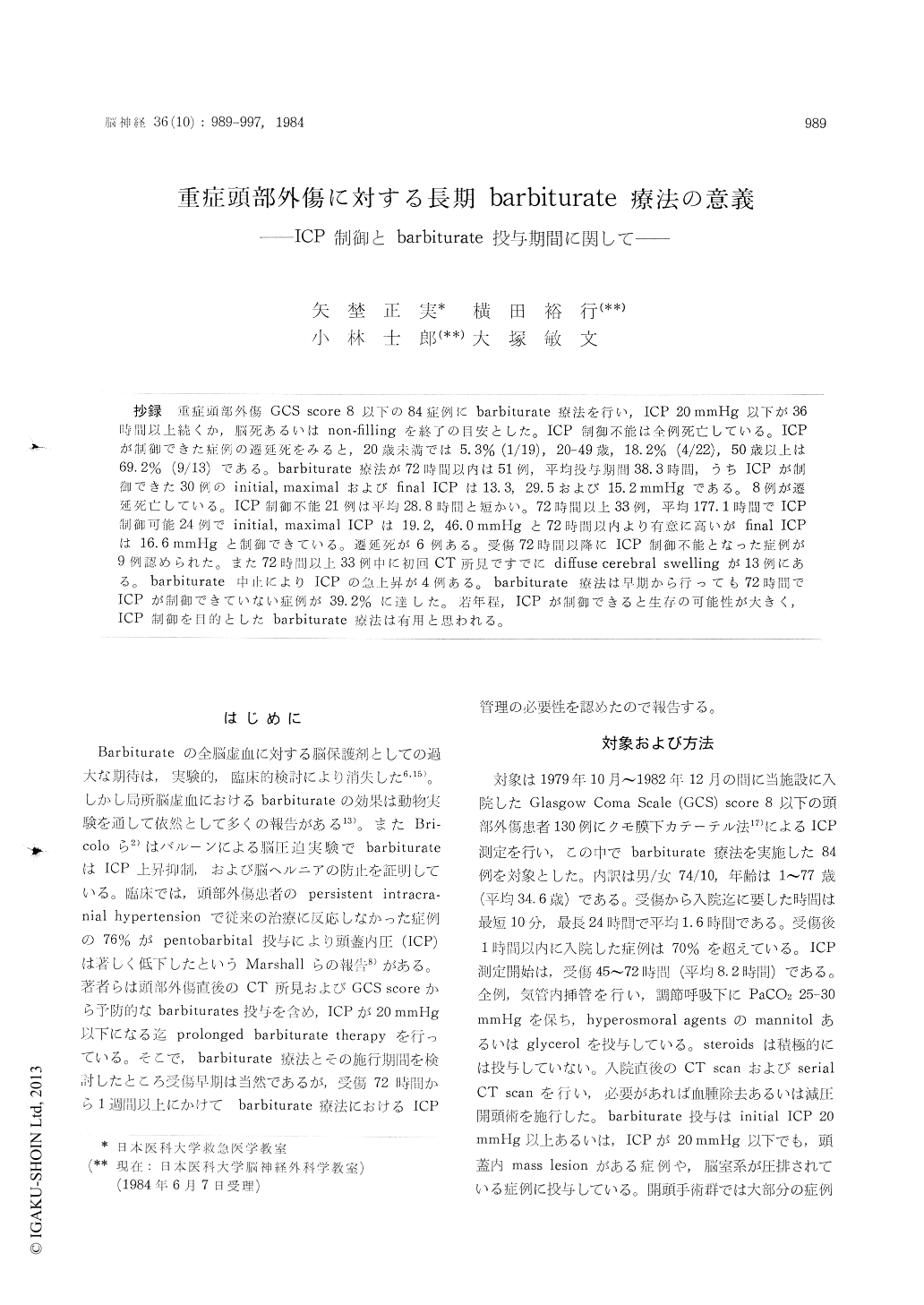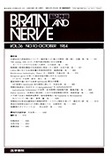Japanese
English
- 有料閲覧
- Abstract 文献概要
- 1ページ目 Look Inside
抄録 重症頭部外傷GCS score 8以下の84症例にbarbiturate療法を行い,ICP 20mmHg以下が36時間以上続くか,脳死あるいはnon-fillingを終了の目安とした。ICP制御不能は全例死亡している。ICPが制御できた症例の遷延死をみると,20歳未満では5.3%(1/19),20-49歳,18.2%(4/22),50歳以上は69.2%(9/13)である。barbiturate療法が72時間以内は51例,平均投与期間38.3時間,うちICPが制御できた30例のinitial,maximalおよびfinal ICPは13.3,29.5および15.2mmHgである。8例が遷延死亡している。ICP制御不能21例は平均28.8時間と短かい。72時間以上33例,平均177.1時間でICP制御可能24例でinitial, maximal ICPは19.2,46.0mmHgと72時間以内より有意に高いがfillnal ICPは16.6mmHgと制御できている。遷延死が6例ある。受傷72時間以降にICP制御不能となった症例が9例認められた。また72時間以上33例中に初回CT所見ですでにdiffuse cerebral swellingが13例にある。barbiturate 中止によりICPの急上昇が4例ある。barbiturate療法は早期から行っても72時間でICPが制御できていない症例が39.2%に達した。若年程,ICPが制御できると生存の可能性が大きく,ICP制御を目的とした arbiturate療法は有用と思われる。
Barbiturate therapy was performed on 84 head trauma patients which were measured on GCS score of 8 or less, through October 1979 to Decem-ber 1982. More than 3 g/day of thiamylal or more than 1.5g/day of pentobarbital were administered for barbiturate therapy. Barbiturate therapy was discontinued in patients whose ICP remained less than 20mmHg for more than 36 hours. In patients whose ICP sustained higher level, barbiturate was administered continuously until brain death was confirmed or non-filling was recognized. The pa-tients were divided into two groups ; Group I in which barbiturate therapy was carried out for 72 hours or less, and Group II in which it was admi-nistered for more than 72 hours. The patients in each group were further divided into responder and survivor ( a ), responder but late death ( b ), and no-responder or acute brain death ( c ), As far as age of patients concern, 19 out of 26 patients whose age was less than 20, 22 out of 35 patients whose age was 20-50 and 13 out of 23 patients whose age was more than 50 years responded well to the barbiturate therapy. But one patient died among young age, 4 patients died among middle age and 9 patients died among aged group at later stage. As for Group I (51 patients), Group I a consisted of 22 patients (mean age ; 26. 2 years, mean GCS score ; 6 04, mean initial and maximal ICP ; 11.9 and 27.8mmHg), I b of 8 (52.5 years, 4.75, 17.0 and 27.8mmHg), and I c of 21 (41.4 years, 4.57, 38.1 and 98.0 mmHg res-pectively). The mean duration of barbiturate administration in three groups was extremely shorter than 48 hours (i. e., 44 47. 4 and 28. 8 hours respectively). Concerming Group II (33) II a was comprised of 18 patients (mean age ; 27.2 years, GCS score ; 5.50, mean initial and maximal ICP ; 19.3 and 45.2mmHg), II b of 6 (48.3, 4.66, 18.7 and 48.5) and IIc of 9 (33.1, 5.22, 24.8 and 75.6 respectively). The duration of barbiturate administration in three groups averaged 184.6, 194.8 and 150.3 hours respectively. The mean initial and maximal ICP of II a+II b was higher than that of I a+I b significanly (P<0.01). In Group II, there were 11 patients which barbitu-rate therapy had to continue for one week or mare. The mean base-line ICP after one to seven days of injury remained more than 20 mmHg. The time of the peak base-line ICP of 11 patients, was 5.9 days after injury. In Group II, 13 patients lied diffuse cerebral swelling which ICP was dif-ficult to control, but 4 out of 13 (30.8%) died with non filling under barbiturate therapy. Furthermore,there were 4 patients in which ICP was increased uncontrollablly, as a result of discontinuation of barbiturate administration. If barbiturate therapy is abruptly discontinued, there is a risk of steep ICP elevation. Consequently, it was found in two groups ; one which responded to barbiturate froman early stage and another which required prolong-ed barbiturate therapy. In our study, prolonged barbiturate therapy in younger age patients would be recommended for good outcome of patients with head injury.

Copyright © 1984, Igaku-Shoin Ltd. All rights reserved.


